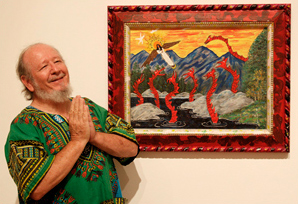Robert Roberg: Street-preaching Artist

Robert Roberg
Robert Roberg is the quintessential self-taught Outsider artist. Having lived a life on the fringes of society, he has something to say. As a street corner preacher with no church affiliation in Nashville, Tennessee, Mr. Roberg warned passersby about their future existence in the netherworld. He knew that his talk of beauty, peace and universal love fell upon deaf ears. These people were doomed, yet Mr. Roberg was determined and dogged on his mission from Yahweh to save them. Usually he was more likely to be physically and verbally abused than heeded. Nevertheless, he was undeterred.
From the Word being ignored by sinners and his being antagonized and roughed up, Mr. Roberg was alienated and alone in the material world. He developed an edgy interpretation of scripture. Mr. Roberg thought that those who preach the Word and those who profess to follow it were “blinded by so many centuries of dogma that they cannot read the simple words of Christ about peace.” His life changed one day, though his message remained ever strong, when out of desperation he picked up chalk and illustrated the meaning of scripture on the sidewalk. Suddenly people stopped, looked and even paid attention to his preaching.
Painting remains his way of reaching people in need of redemption because strangers listen and interact positively in the glow of his florescent-colored images radiating in night-light. He generally paints beneath streetlamps, preferring to engage people at night, trying to attract the many “lost sheep being led astray by hungry wolves.”

Robert's World View
Robert Roberg was part of an Amish-Mennonite group whose members, he believed, would be saved because of their ultraconservative practices; they also believed that everyone else, including most Christians, were damned. Their teaching of non-violence flew in the face of what Christians said and did. “All other Christian groups go to war,” Mr. Roberg said, adding, “When I was rejected by everyone in the street, the most hostile were other Christians. Those who preach militarism in Jesus’ name are preaching damnable lies.”
Last year Mr. Roberg invited me to his storage facility in Gainesville, Florida, where he uncovered paintings that had never been seen. Many of these were made for his Book of Revelation series. I saw them as his interpretations, though he would say that they are not, claiming that they portray the meaning of the Bible. “Originally I thought my paintings were illustrations and not interpretations. I still think of them as illustrations but now I interpret them to those who stop and listen,” he explains. No self-taught artist, I thought, was better primed to critique organized religion than Mr. Roberg.
Mr. Roberg had become obsessed with the Book of the Revelation and over the course of meeting thousands of people on the street and painting all the horrible things that would happen to them as described in the Book of Revelation, he realized that “I loved all the people and would not do that to even one of them.” He mused: “If I, a mere man, would not harm these people but only had love for them then surely that is the way God is.” He began to question the Book and all that he had believed.
He explains, “Looking at the whole book, God comes off as a peevish, flip-flopping tyrant who wallows in blood. It was then that it hit me that Jesus never taught this and all those other writers had it wrong. The God of Jesus is loving and kind. This put me way out of step with the Amish-Mennonites and I left the church.” Mr. Roberg continues to paint on the streets and is still working on the Revelation project. But now when people stop he assures them that the depictions he paints “are not God’s plan, and He loves them and is bringing them all home.”
That is the message behind Robert Roberg’s content-driven artwork. His Book of Revelation project may well become an exemplary work in the field of self-taught art, a field that has spilled over into the academic and museum cultures, where it will find its place. |
|